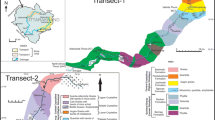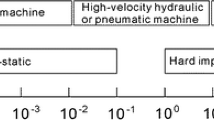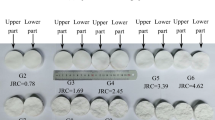Abstract
Three types of marls can be found in the Tabriz area (Iran): yellow, green, and gray/black marls. In the present paper, strength and deformation characteristics of Tabriz marls and their stress–strain behavior are investigated by various in situ and laboratory tests. In order to study the deformation behavior of these marls, various experiments such as the pressuremeter test, plate loading test (PLT), seismic wave velocity test, uniaxial compression test, standard penetration test (SPT), and direct shear test were carried out. Ranges of strain at the elastic and failure points were determined. Young’s and shear modulus were obtained. Test results showed that the strength characteristics increase with depth. The value of deformation modulus determined by the pressuremeter test was in good agreement with those obtained from the PLT. This implies that pressuremeter is a suitable in situ test for characterizing the deformation modulus of marl. Deformation modulus obtained from pressuremeter and plate loading tests were approximately 4–5 times the results of uniaxial compressive test and the deformation modulus obtained from seismic data was about 30–50 times the static deformation modulus. Stress–strain curves showed that the maximum value of strain at the elastic and failure points and the minimum value of strength and deformation modulus are corresponding to the yellow marls while the minimum value of strain and the maximum value of strength and deformation modulus are corresponding to the gray/black marls. Some empirical relationships between different characteristics of Tabriz marls were also derived.























Similar content being viewed by others
References
AASHTO (1988) AASHTO Manual on subsurface investigations. American Association of State Highway and Transportation Officials, Washington DC, USA
Akili W, Torrance JK (1981) The development and geotechnical problems of sabkha, with preliminary experiments on the static penetration resistance of cemented sands. Q J Eng Geol 14(2):59–73
Alber M, Heiland J (2001) Investigation of a limestone Pillar failure: part 1; geology, laboratory testing and numerical modeling. Rock Mech Rock Eng 34(3):167–186
Al-Rawas AA, Hago AW, Al-Sarami H (2005) Effect of lime, cement and saroj (artificial pozzolan) on the swelling potential of an expansive soil from Oman. Build Environ 40:681–687
Amar S, Clark BGF, Gambin MP, Orr TLL (1991) The application of pressuremeter test result to foundation design in Europe: part 1. International society for soil mechanics and foundation engineering: European Regional Technical Committee
Anagnostopoulos AG, Kalteziotis N, Tsiambaos GK, Kavvadas M (1991) Geotechnical properties of the Corinth Canal marls. Geotech Geol Eng 9(1):1–26
ASTM (1994) Standard test method for probed pressuremeter testing in soils, ASTM D4719. USA
Athanasopoulos GA (1995) Utilization of sample disturbance for dating a marl deposit. Geotech Geol Eng 13(2):93–104
Athmania D, Benaissa A, Hammadi A, Bouassida M (2010) Clay and marl formation susceptibility in Mila province, Algeria. Geotech Geol Eng 28(6):805–813
Atkinson JH (1993) An introduction to the mechanics of soils and foundation. McGraw Hill Inc., Series in Civil Engineering
Behnia K, Ouhadi VR, Ghalandarzadeh A (1993) The use of sea-water in stabilization of marly soils with cement and lime. Iranian J Road Eng 26:54–62
Bowles JE (1996) Foundation analysis and design, 5th edn. McGraw Hill Inc, New York
Chen FH (1988) Foundations on expansive soils. Developments in Soils Geotechnical Engineering, vol 54. Elsevier, New York
Corthésy R, Leite MH, Gill DE, Gaudin B (2003) Stress measurements in soft rocks. Eng Geol 69:381–397
El Amrani N, Lamas F, Irigaray C, Chacón J (1998) Engineering geological characterization of Neogene marls in the Southeastern Granada Basin (Granada, Spain). Eng Geol 50:165–175
Holtz RD, Kovacs WD (1981) An introduction to geotechnical engineering. Prentice-Hall, Englewood Cliffs
Johnes DE, Holtz WG (1973) Expansive soils: the hidden disaster. ASCE Civil Eng 43(8):49
Kelly WE, Mares S (1993) Applied geophysics in hydrogeological and engineering practice. Elsevier, Amsterdam
Khamehchiyan M, Iwao Y, Amirsoleymani T (1994) Effect of carbonate content on engineering properties of marl rocks. In: Proceedings of the 7th international congress IAEG, Rotterdam, pp 597–602
Lamas F, Irigaray C, Chacόn J (2002) Geotechnical characterization of carbonate marls for the construction of impermeable dam cores. Eng Geol 66:283–294
Lamas F, Irigaray C, Chacón J (2005) Selection of the most appropriate method to determine the carbonate content for engineering purposes. Eng Geol 81(1):32–41
Maccarini M (1987) Laboratory studies of a weakly bonded artificial soil. PhD thesis, University of London, London, UK
Malandraki V (1994) The engineering behaviour of a weakly bonded artificial soil. PhD thesis, University of Durham, Durham, UK
Malandraki V, Toll DG (2000) Drained probing triaxial tests on a weakly bonded artificial soil. Geotechnique 50(2):141–151
Malandraki V, Toll DG (2001) Triaxial tests on a weakly bonded artificial soil with changes in stress path. ASCE J Geotech Geoenviron Eng 127(3):282–291
Mohamed AMO (2000) The role of clay minerals in marly soils on its stability. Eng Geol 57:193–203
Mohamed AMO, Yong RN, Mohammed LF (1991) Soil improvement using chemical treatment. In: Proceedings of the first geotechnical engineering conference, Cairo University, Egypt, pp 1–10
NCEER (1997) Proceeding of the NCEER workshop on evaluation of liquefaction resistance of soils. In: Voud TL, Idris I (eds) Technical Report, NCEER-7-0022.
Nelson JD, Miller DJ (1992) Expansive soils problems and practice in foundation and pavement engineering. Wiley, New York
Ouhadi VR (1997) The role of marl components and ettringite on the stability of stabilized marl. PhD Thesis, McGill University, Montreal, Canada
Ouhadi VR, Yong RN (2003) The role of clay fraction of marly soils on their post stabilization failure. Eng Geol 70:365–375
Ouhadi VR, Ghalandarzadeh A, Behnia K (1993) Engineering characteristics and properties of marly soils. In: Proceedings of the second international seminar on soil mechanics and foundation engineering of Iran, Tehran, Iran, pp 36–48
Pettijohn FJ (1975) Sedimentary rocks, 3rd edn. Harper and Row, New York
Ruwaih IA (1987) Experiences with expansive soils in Saudi Arabia. In: Proceedings of the sixth international conference on expansive soils, New Delhi, India, International Society for Soil Mechanics and Foundation Engineering (ISSMFE), pp 317–322
Sanad H, Bader B (1990) Laboratory study on leaching of calcareous soil from Kuwait. J Geotech Eng 116(12):1797–1809
Shalabi FI, Al-Qablan HA, Al-Hattamleh OH (2009) Elasto-plastic behavior of Raghadan tunnel based on RMR and Hoek–Brown classifications. Geotech Geol Eng 27(2):237–248
Toll DG, Malandraki V (1993) Triaxial testing of a weakly bonded soil. In: Proceedings of the international symposium on geotechnical engineering of hard soils-soft rocks, Balkema, Rotterdam, The Netherlands, pp 817–823
Trenter NA (1989) Some geotechnical problems in the Middle East. In: Proceedings of the 1st regional congress on civil engineering, University of Bahrain, Bahrain, pp 1–22
US Department of the Interior (1998) Earth manual, part 1. Third ed. Bureau of Reclamation, USA
Venkatramaiah C (1993) Geotechnical engineering. Wiley Eastern Limited, New Delhi, pp 660–666
Yong RN, Ouhadi VR (1997) Reaction factors impacting on instability of bases on natural and lime-stabilized marls. Special Lecture, Keynote Paper. In: Proceeding of the international conference on foundation failures, Singapore, pp 87–100
Yong RN, Ouhadi VR (2007) Experimental study on instability of bases on natural and lime/cement-stabilized clayey soils. Eng Geol 35:238–249
Yong RN, Ouhadi VR, Mohamed AMO (1996) Physico-chemical evaluation of failure of stabilized marl soil. In: Proceedings of the 49th Canadian geotechnical conference frontiers in geotechnology, vol 2, pp 769–776
Acknowledgments
The authors are grateful to Pazhoohesh Omran Rahvar Consulting Engineers for their collaboration in preparing the tests data. The authors also gratefully acknowledge the useful comments of anonymous reviewers on an earlier version of this paper.
Author information
Authors and Affiliations
Corresponding author
Rights and permissions
About this article
Cite this article
Hooshmand, A., Aminfar, M.H., Asghari, E. et al. Mechanical and Physical Characterization of Tabriz Marls, Iran. Geotech Geol Eng 30, 219–232 (2012). https://doi.org/10.1007/s10706-011-9464-3
Received:
Accepted:
Published:
Issue Date:
DOI: https://doi.org/10.1007/s10706-011-9464-3




